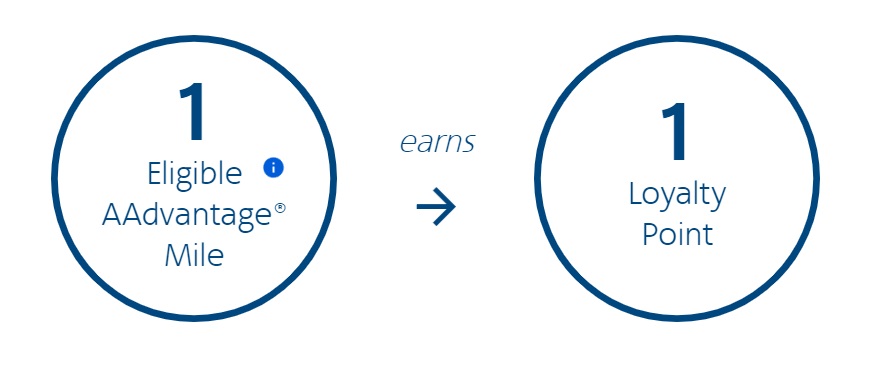A couple of weeks have passed since American Airlines AAdvantage shocked everybody with its new system for elite status qualification – click here to re-read our original article. Now that the shock is wearing off, the implications are becoming more obvious.
Instead of the messy EQD and EQM dual requirement, American’s new concept of Loyalty Points will include credit card spend. Some other on-the-ground partner transactions will also count as a Loyalty Point, but realistically only credit card spend will be relevant…

How many Loyalty Points will I need?
To earn elite status, you will require:
- AAdvantage Gold status –> 30,000 Loyalty Points
- AAdvantage Platinum status –> 75,000 Loyalty Points
- AAdvantage Platinum Pro status –> 125,000 Loyalty Points
- AAdvantage Executive Platinum status –> 200,000 Loyalty Points
How does this compare to the alternatives?
AAdvantage isn’t the only option available to frequent flyers interested in elite status with a Oneworld airline. Alaska Airline’s Mileage Plan, British Airways Executive Club, or even Iberia Plus are all relevant alternatives. This is especially true for international Business Class travellers (one of the most lucrative for any frequent flyer program / airline).
London – New York
This route covers 3,450 miles. When flying on British Airways in Business Class, a new member could earn:
- AAdvantage – 125% of miles flown –> 4,312 Loyalty Points
- Alaska – 150-250% of miles flown –> 5,175 – 8,625 Elite-Qualifying miles
- British Airways – 140 Tier Points
If we are targeting Oneworld Sapphire status – i.e. AAdvantage Platinum, Alaska MVP Gold or British Airways Silver status – when flying Business Class, here’s what we would need…
- AAdvantage – 75,000 Loyalty Points
- Alaska – 40,000 Elite-Qualifying miles
- British Airways – 600 Tier Points
Meaning that you need the following number of London / New York segments in Business Class to earn Oneworld Sapphire status
- AAdvantage – 7 segments as “member”, 6 more segments as “Gold” – 13 segments in total
- Alaska – 5-8 segments (depending on fare class)
- British Airways – 4.2 segments
(I could repeat the numbers for Oneworld Emerald status, but the conclusion would be similar)
If the “no status” AAdvantage member flew on American Airlines (instead of a partner airline like BA), they would earn 5 miles per $ spent (excluding taxes). A leisure traveller paying $1,000 each way would see little added benefit (i.e. 5,000 Loyalty Points per segment). Flexible J fares can, of course, be much more expensive…
The “Foolish” Conclusion
There are dozens of potential permutations of route and fare class of course. And not all are going to be as unfavorable to AAdvantage as my random example shown above. Because tier bonuses will count as Loyalty Points, an existing Executive Platinum member with their 120% bonus won’t require nearly as many segments to requalify for elite status.
But if you were a young frequent flyer just starting out – for example, after joining a bank or consultancy coming out of business school – should you be choosing AAdvantage? NOT AT ALL!!!
And if you live in a country that doesn’t offer an AAdvantage co-branded credit card, should you switch over to AAdvantage? NO NO NO!!!
As a result, AAdvantage is inviting the next generation of US frequent flyers, as well as the rest of the world, to choose a different frequent flyer program to focus on —> FOOLISH.
Why this move could be “Genius”
The joke has been made by people far cleverer than me, but the major US-based airlines are just credit card reward programs with wings attached. Selling miles to banks is BY FAR the most lucrative element of operating an airline (and conversely, issuing miles/points/etc is practically the ONLY way for a bank to entice cardholders to use their bank’s cards).
But as Citi and Barclays are no doubt aware, co-branded AAdvantage credit cards are far from the most lucrative options in the market today. An AAdvantage co-branded card is at best going to offer:
- 2 miles per $ spent with American and certain select merchant categories
- 1 mile per $ spent elsewhere
So, the average AAdvantage cardholder might bank a sign-up bonus, but otherwise only use their card when buying AA flights. Because, quite frankly, AA redeemable miles aren’t worth enough to compete with a 2% cashback card, not to mention any card offering 5x or better category bonuses…
But the calculus completely changes when elite status comes into play – i.e. Loyalty Points. Not only are you earning redeemable miles, but you are working your way up to higher levels of elite status. I doubt that it matters for infrequent flyers, but “status miles” have a pull that is hard to quantify for frequent flyers. It might just be enough to incentivize American’s frequent flyers to also put the majority of their spend through their AAdvantage credit card.
Stupidity or Genius?
Anything that increases credit card spend is going to be highly profitable for American Airlines. If it works as planned, American’s profits could increase substantially.
But if it fails? American has just told the world that only co-branded credit card holders need concern themselves with AA elite status. I suspect that British Airways, Alaska Airlines and other Oneworld airlines might just be the main beneficiaries of this change, as their loyalty programs see increased use.
How will we know? Whenever AAdvantage drastically reduces the required number of Loyalty Points needed for elite status and/or starts offering fast tracks and status matches to all…




